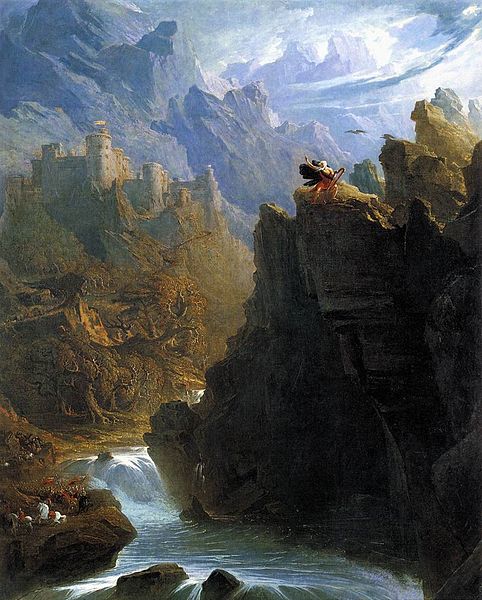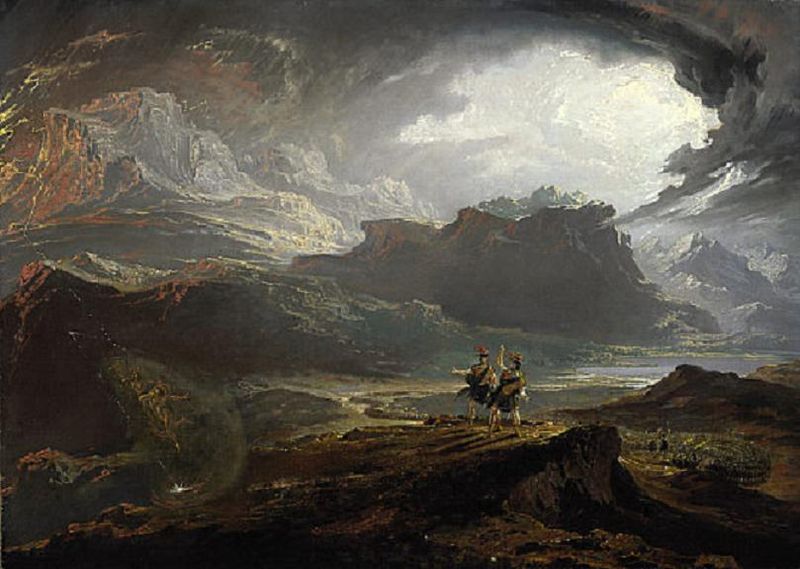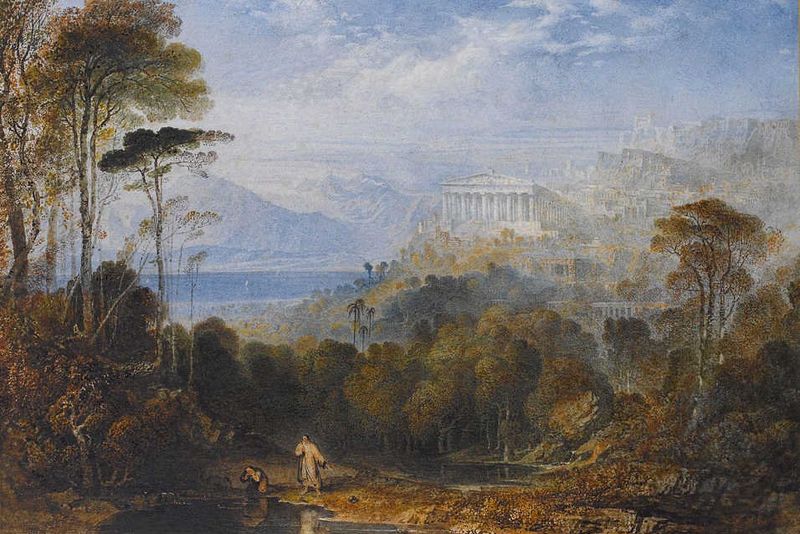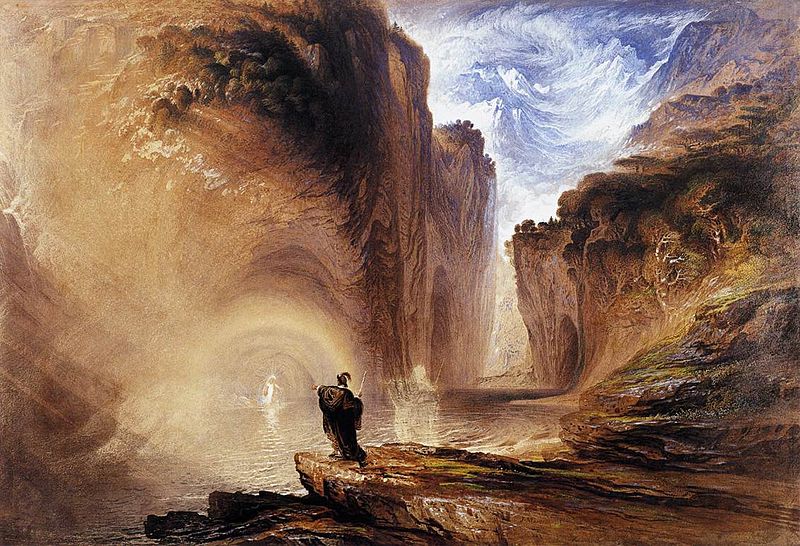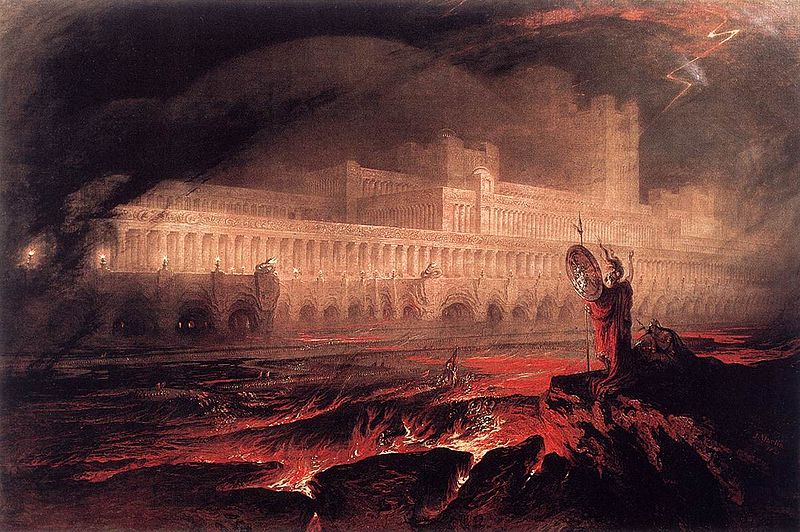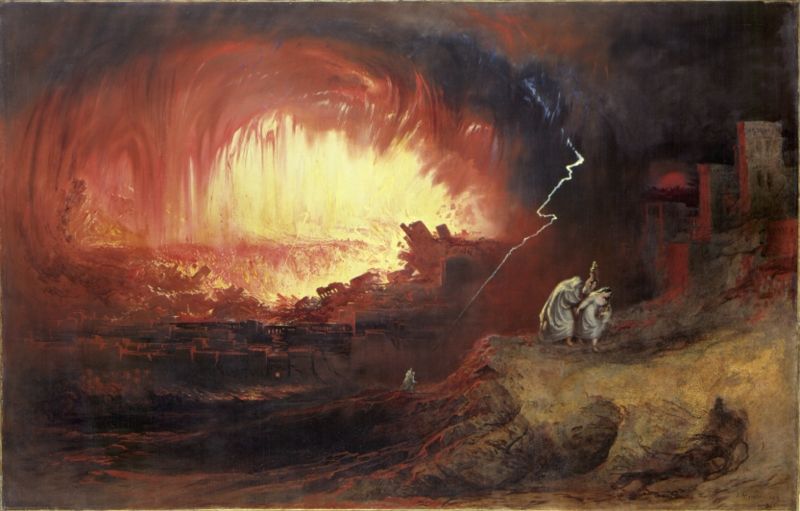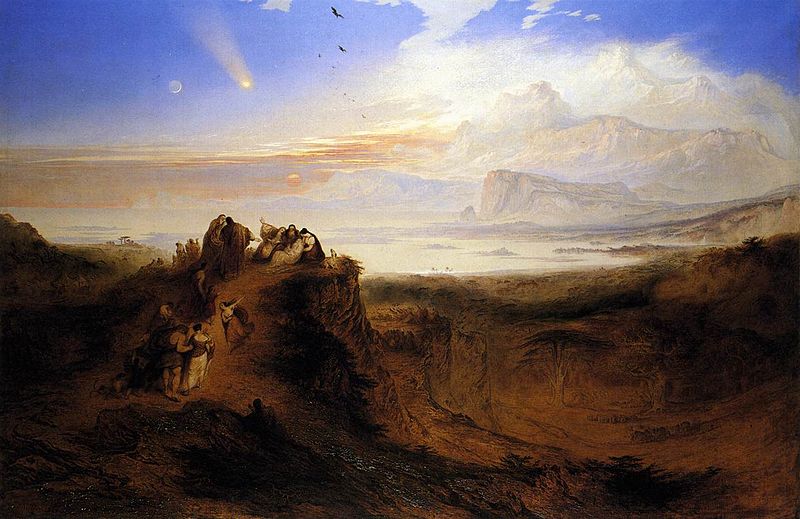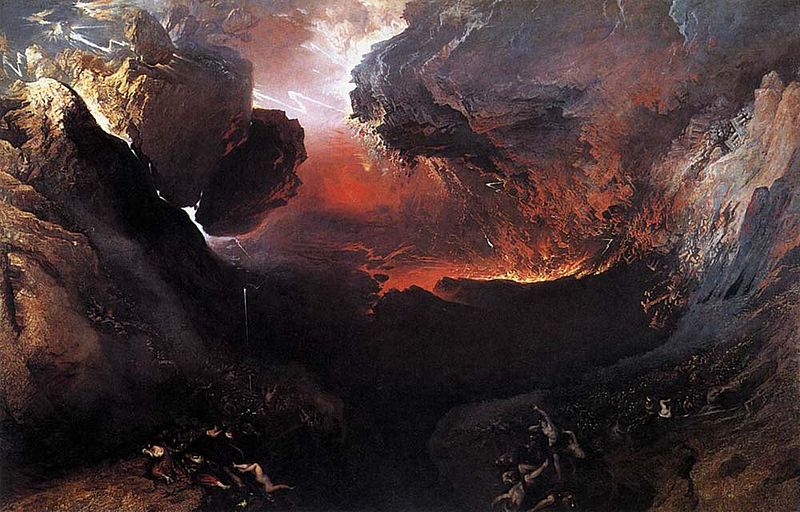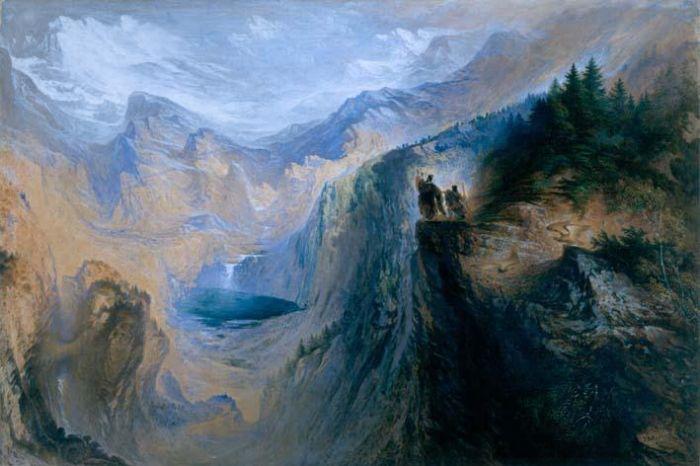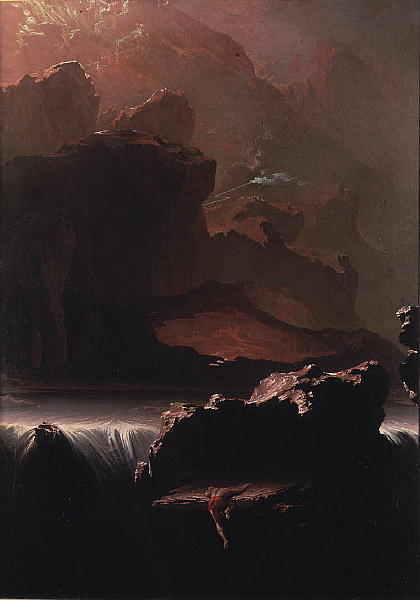<Back to Index>
- Philosopher Herbert Marcuse, 1898
- Painter John Martin, 1789
- Prime Minister of Portugal Francisco Manuel Lumbrales de Sá Carneiro, 1934
PAGE SPONSOR
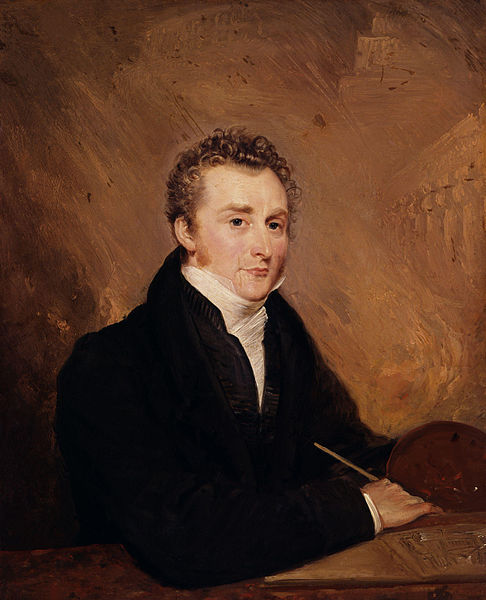
John Martin (19 July 1789 – 17 February 1854) was an English Romantic painter, engraver and illustrator.
Martin was born in July 1789, in the week that the Bastille was stormed in Paris, at Haydon Bridge, near Hexham in Northumberland, the 4th son of Fenwick Martin, a one time fencing master. He was apprenticed by his father to a coach builder in Newcastle upon Tyne to learn heraldic painting, but owing to a dispute over wages the indentures were cancelled, and he was placed instead under Boniface Musso, an Italian artist, father of the enamel painter Charles Muss. With his master, Martin removed from Newcastle to London in 1806, where he married at the age of nineteen, and supported himself by giving drawing lessons, and by painting in watercolours, and on china and glass - his only surviving painted plate is now in a private collection in England. His leisure was occupied in the study of perspective and architecture. His brothers were William, the eldest, an inventor; Richard, a soldier who fought in the Peninsular War and at Waterloo; and Jonathan, a preacher tormented by madness who set fire to York Minster in 1829, for which he stood trial.
Martin began to supplement his income by painting sepia watercolours. He sent his first oil painting to the Royal Academy in 1810 but it was not hung. In 1811 he sent the painting once again, when it was hung under the title "A Landscape Composition" as item no. 46 in the Great Room. Thereafter, he produced a succession of large exhibited oil paintings: some landscapes, but more usually grand biblical themes inspired by the Old Testament. His landscapes have the ruggedness of the Northumberland crags, while some authors claim that his vast apocalyptic canvasses, like The Destruction of Sodom and Gomorrah show his familiarity with the forges and ironworks of the Tyne Valley – certainly, they display his intimate knowledge of the Old Testament. His timing could not have been better. In the years of the Regency from 1812 onwards there was a fashion for such ‘sublime’ paintings, encouraged by the publications of travellers returning from the Grand Tour or the Middle East with exotic tales of places like Ur and Babylon, Pompeii and Alexandria.
Martin’s break came at the end of a season at the Royal Academy, where his first great sublime canvas Sadak in Search of the Waters of Oblivion had been hung – and ignored. He brought it home, only to find there a visiting card from William Manning MP, a governor of the Bank of England. Manning wanted to buy it from him.
Such influential patronage propelled Martin’s career onto a major stage though he was never, to his disgust, elected to the Royal Academy. This promising career was interrupted though, by the death of his father, mother, grandmother and young son – all in a single year. Another distraction was William, who frequently asked him to draw up plans for his inventions, and whom he always indulged with help and money. But, heavily influenced by the works of Milton, he continued with his grand themes, despite a number of financial and artistic setbacks - one of his works was ruined while waiting to be hung at the Academy by a careless artist spilling a pot of dark varnish over it. In 1816 he finally achieved public acclaim with Joshua Commanding the Sun to Stand Still upon Gibeon, an immense theme which struck a popular chord even though it broke many of the conventional rules of composition. In 1818, on the back of the sale of the Fall of Babylon for £420, he finally rid himself of debt and bought a house in Marylebone - then, as now, a fashionable and desirable part of London, where he came into contact with a wide range of artists, writers, scientists and Whig nobility.
His triumph was Belshazzar’s Feast, of which he boasted beforehand, “it shall make more noise than any picture ever did before... only don’t tell anyone I said so.” Five thousand people paid to see it. It was later, in a superb historical irony, nearly ruined when the carriage in which it was being transported was struck by a train at a level crossing near Oswestry; in 1841, with John Martin himself on the footplate, Isambard Kingdom Brunel ran a train at 90 mph to disprove Stephenson’s theory that locomotives could not go faster than horses.
In private Martin was passionate, a devotee of chess - and, in common with his brothers, swordsmanship and javelin - throwing - and a devout Christian, believing in "Natural Religion". Despite an often cited singular instance of his hissing at the national anthem, he was courted by royalty and presented with several gold medals, one of them from the Russian Tsar Nicholas, on whom a visit to Wallsend colliery on Tyneside had made an unforgettable impression: ‘My God,’ he had cried, ‘it is like the mouth of Hell.’ Martin became the official historical painter to Prince Leopold of Saxe - Coburg – Queen Victoria’s ‘dearest Uncle’ - who would have been Queen Charlotte’s consort had she lived, and who later became the first King of Belgium, where he constructed Europe’s first major railway. Leopold was the godfather of Martin’s son Leopold, and endowed Martin with one of Belgium’s first knighthoods, the Order of Leopold. Martin frequently had early morning visits from another Saxe - Coburg, Prince Albert, who would engage him in banter from his horse – Martin standing in the doorway still in his dressing gown – at seven o'clock in the morning. Martin, and his highly intelligent wife Susan were warm and affectionate friends to many, but he was also a passionate defender of deism and Natural Religion, evolution (long before Darwin) and rationality.
Georges Cuvier, the great French naturalist, became an admirer of Martin’s, and he increasingly enjoyed the company of scientists, artists and writers – Dickens, Faraday and Turner among them. He began to experiment with mezzotint technology, and as a result was commissioned to produce 24 engravings for a new edition of Paradise Lost – perhaps the definitive illustrations of Milton’s masterpiece, of which copies now fetch many hundreds of pounds. Politically his sympathies are not clear; some claim he was a radical, but this is not bourne out by known facts; although he knew William Godwin, the ageing reformed revolutionist, husband of Mary Wollstonecraft and father of Mary Shelley; and John Hunt, co-founder of The Examiner.
At one time the Martins took under their wing a young woman called Jane Webb, who at twenty produced The Mummy a novel almost as influential as Frankenstein. The Mummy was a socially optimistic but satirical vision of a steam driven world in the 22nd century, the progenitor of a hundred books and as many movies. Another friend was Charles Wheatstone, professor of physics at King’s College, London. Wheatstone experimented with telegraphy and invented the concertina and stereoscope; Martin was fascinated by his attempts to measure the speed of light. Accounts of Martin’s evening parties reveal an astonishing array of thinkers, eccentrics and social movers; one witness was a very young John Tenniel - later illustrator of Lewis Carroll’s work - who was heavily influenced by Martin and who was a close friend of his children. At various points Martin’s brothers were also among the guests – their eccentricities and conversation adding to the already exotic flavour of the fare.
Martin himself might have been even more famous if he had not for nearly a decade from about 1827 - 28 turned away from his painting career to become involved with his many plans and inventions. His brother Jonathan’s trial for setting fire to York Minster also proved an expensive burden. John Martin developed a fascination with solving London’s water and sewage problems, involving the creation of the Thames embankment containing a central drainage system. His plans were visionary: they show a fine engineering brain coupled with the artistic vision that would have made London a city of European grandeur. They formed the basis for many later engineers’ designs – Joseph Bazalgette’s included - and were approved by Michael Faraday and Martin’s great artistic competitor, Turner. These plans, along with railway schemes, an idea for ‘laminating timber’, lighthouses, and draining islands, all survive. Debt and family pressures, including the suicide of his nephew – Jonathan’s son Richard, brought depression which reached its worst in 1838. However, from 1839 Martin's fortunes recovered and he exhibited many works during the 1840's, culminating in his triumphal Last Judgment trilogy of paintings (Tate Britain, London) which were completed in 1853, just before the stroke which paralysed his right side. He was never to recover and died on February 17th, 1854. Major exhibitions of his works are still mounted.
A number of Martin’s works survive in public collections: the Laing Art Gallery in Newcastle - which also holds his famous ‘black cabinet’ of projects in progress; Tate Britain, the Victoria & Albert Museum, the Louvre, the National Gallery of Art Washington DC, Yale Center for British Art, St. Louis Art Museum and elsewhere in the USA. The RIBA holds many of his engineering pamphlets. There are letters in private collections and at Queen Mary College in London. John Martin wrote two autobiographies, the first an article in The Athenaeum of June 14th 1834, page 459 and the most extensive in The Illustrated London News, March 17th 1849, pp. 176 - 177. A major source for his life is a series of reminiscences by his son Leopold, published in sixteen parts in the Newcastle Weekly Chronicle in 1889. There are a number of surviving letters and reminiscences by, among others, B.R. Haydon, John Constable, Ralph Waldo Emerson, the Rossettis, Benjamin Disraeli, Charlotte Brontë and John Ruskin – a persistent critic who, even so, admitted Martin's uniqueness of vision. The first full biography was that by Mary L. Pendered whose chief source, Martin’s friend Sergeant Ralph Thomas, wrote a diary - now lost - of their friendship. Thomas Balston then wrote two biographies on the artist, the first in 1934, and the second (still the leading biography) in 1947. Christopher Johnstone produced an introductory book on Martin 1974, and in 1975 the art critic William Feaver was author of an extensively illustrated work on Martin's life and works. Since 1986, Michael J. Campbell has produced a number of publications on John Martin, including the leading publication on his work as an original printmaker, published by the Royal Academy of Arts, Madrid, in 2006.
John Martin’s influence survived in perhaps curious places. One of his followers was Thomas Cole, founder of American landscape painting. Others whose imaginations were fired by him included Ralph Waldo Emerson, the Brontës - who as children played with a model of him, the pre-Raphaelites - especially Rossetti, and several generations of movie makers, from DW Griffiths, who borrowed his Babylon from Martin, to Cecil B de Mille and George Lucas. Writers like Rider Haggard, Jules Verne and HG Wells were influenced by his concept of the sublime. The French Romantic movement, in both art and literature, was inspired by him. Much Victorian railway architecture was copied from his motifs, including his friend Brunel’s Clifton suspension bridge. A number of Martin’s engineering plans for London which included a circular connecting railway, though they failed to be built in his lifetime, came to fruition many years later. This would have pleased him inordinately – he is known to have exclaimed to his son, Leopold, that he would rather have been an engineer than painter.
John Martin died on the Isle of Man on February 17th, 1854. He is buried in Kirk Braddon cemetery. His first exhibited subject picture, Sadak in Search of the Waters of Oblivion (now in the St. Louis Art Museum), was hung in the Ante-room of the Royal Academy in 1812, and sold for fifty guineas. It was followed by the Expulsion (1813), Adam's First Sight of Eve (1813), Clytie (1814), Joshua Commanding the Sun to Stand Still upon Gibeon (1816) and The Fall of Babylon (1819). In 1821 appeared his Belshazzar's Feast, which excited much favorable and hostile comment, and was awarded a prize of £200 at the British Institution, where the Joshua had previously carried off a premium of £100. Then came the Destruction of Pompeii and Herculaneum (1822), The Creation (1824), the Eve of the Deluge (1841), and a series of other Biblical and imaginative subjects. The Plains of Heaven is thought by some to reflect his memories of the Allendale of his youth. Martin's large paintings were closely connected with contemporary dioramas or panoramas,
popular entertainments in which large painted cloths were displayed,
and animated by the skilful use of artificial light. Martin has often
been claimed as a forerunner of the epic cinema, and there is no doubt
that the pioneer director D.W. Griffith was aware of his work." In turn, the diorama makers borrowed Martin's work, to the point of plagiarism. A 2,000 square foot (190 m2) version of Belshazzar's Feast was
mounted at a facility called the British Diorama in 1833; Martin tried,
but failed, to shut down the display with a court order. Another
diorama of the same picture was staged in New York City in 1835. These
dioramas were tremendous successes with their audiences, but wounded
Martin's reputation in the serious art world. The painting The Destruction of Sodom and Gomorrah, 1852 is currently at the Laing Art Gallery in Newcastle upon Tyne.
In
addition to being a painter, John Martin was a major mezzotint engraver
and for significant periods of his life he earned more from his
engravings than his paintings. In 1823, Martin was commissioned by
Samuel Prowett to illustrate John Milton's Paradise Lost,
for which he was paid 2000 guineas. However, before the first 24
engravings were completed he was paid a further 1500 guineas for a
second set of 24 engravings on smaller plates. Some of the more notable
prints include Pandæmonium and Satan Presiding at the Infernal Council, remarkable for the science fiction element visible in the depicted architecture, and arguably his most dramatic compostion Bridge over Chaos.
Prowett issued 4 separate editions of the engravings in monthly
installments, the first appearing on 20 March 1825 and the last in
1827. Later, inspired by Prowett’s venture, between 1831 and 1835
Martin published his own illustrations to the Old Testament but the
project was a serious drain on his resources and not very profitable.
He sold his remaining stock to Charles Tilt who republished them in a
folio album in 1838 and in a smaller format in 1839. Martin enjoyed immense popularity and a print of Belshazzar's Feast hung on the parlour wall of the Brontë parsonage in Haworth,
and his works were to have a direct influence upon the writings of
Charlotte and her sisters. Martin's fantasy architecture influenced the
Glasstown and Angria of the Bronte juvenilia, where he himself appears
as Edward de Lisle of Verdopolis. His profile was raised even further
in February 1829 when his older brother, non-conformist Jonathan Martin deliberately set fire to York Minster.
The fire caused extensive damage and the scene was likened by an
onlooker to Martin's work, oblivious to the fact that it had more to do
with him than it initially seemed. Jonathan Martin's defence at his
trial was paid for with John Martin's money. Jonathan Martin, known as
"Mad Martin", was ultimately found guilty but was spared the hangman's
noose on the grounds of insanity. John
Martin was also occupied with schemes for the improvement of London,
and published various pamphlets and plans dealing with the metropolitan
water supply, sewerage, dock and railway systems. His 1834 plans for London's sewerage system anticipated by some 25 years the 1859 proposals of Joseph Bazalgette to create intercepting sewers complete with walkways along both banks of the River Thames. During the last four years of his life Martin was engaged upon a triptych of very large biblical subjects: The Last Judgment, The Great Day of His Wrath, and The Plains of Heaven, of which two were bequeathed to Tate Britain in
1974, the other having been acquired for the Tate some years earlier.
Martin suffered an attack of paralysis while painting and died on the Isle of Man. Like
some other popular artists, Martin fell victim to changes in fashion
and public taste. His grandiose visions seemed theatrical and outmoded
to the mid-Victorians, and after Martin died his works became neglected
and gradually forgotten. "Few artists have been subject to such
posthumous extremes of critical fortune, for in the 1930s his vast
paintings fetched only a pound or two, while today they are valued at
many thousands."
A painting formerly attributed to John Martin
The Fallen Angels Entering Pandemonium
was used as the cover art of the
NWOBHM band Angel Witch for their self titled debut album. The Great Day of His Wrath is used on the cover of Lustmord's iconic album, "Heresy". The Great Day of His Wrath can also be seen adorning a wall in the computer game Zork Nemesis. Ray Harryhausen, pioneering designer, stop - motion animator and developer of the process Dynamation (Jason and the Argonauts 1963 and the first Clash of the Titans 1981) acknowledges the influence of John Martin on his work. Derek Riggs, graphic designer, famous as the creator of the iconic record sleeves of the heavy metal band Iron Maiden was and continues to be inspired by John Martin in his work.
With
his wife Susan, Martin had six children who survived to adulthood:
Alfred (who worked with his father as a mezzotint engraver and later
became a senior tax official), Isabella, Zenobia (who married the artist Peter Cunningham),
Leopold (who became a clerk), Charles (who was trained as a painter by
his father, copying a number of his father's works - he later became a
successful portrait painter and lived in America - his last exhibit at
the Royal Academy was in 1896) and Jessie (who married egyptologist Joseph Bonomi). Leopold was the godson of the future King Leopold I of Belgium, who had
met and befriended Martin when they shared lodgings on Marylebone High
Street in about 1815. Leopold later wrote a series of reminiscences of
his father, published in the Newcastle Weekly Chronicle Supplement in
1889. Leopold accompanied his father on many walks and visits, and his
anecdotes include encounters with J.M.W. Turner, Isambard Kingdom
Brunel, William Godwin and Charles Wheatstone. Leopold married the
sister of John Tenniel, later famous as the cartoonist of Punch and
illustrator of Alice's Adventures in Wonderland.
Martin's
eldest brother, William (1772 – 1851) was by turn a rope - maker, soldier,
inventor, scientist, writer and lecturer, who attempted to develop a
rival philosophy to "Newtonian" science, allowing for perpetual motion,
and denying the law of gravity. Despite undoubted elements of "quackery
and buffoonery", William had a great talent for inventing. In 1819 he
produced a miner's safety lamp which was said to be better and more
reliable than that of Sir Humphry Davy. The only recognition he
achieved in this field was a silver medal from the Royal Society for
the invention of the spring balance. The second eldest brother,
Richard, was a quartermaster in the guards, serving throughout the Peninsular War, and was present at Waterloo. Jonathan, the third eldest brother, (1782 – 1838) achieved notoriety by setting fire to York Minster in February 1829. He was subsequently apprehended, tried and found not guilty on the grounds of insanity - he was confined to St Luke's Hospital for Lunatics in London, where he remained until his death.
